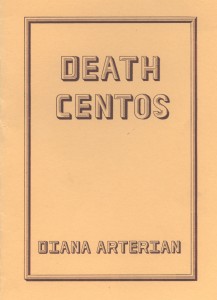Death Centos by Diana Arterian
 Death Centos
Death Centos
by Diana Arterian
Ugly Duckling Presse, 2013
24 pages / UDP Page
When my 12 year old daughter rolls her eyes at me, I tell her stop it. I say, stop it. You shouldn’t treat me like that. I’m going to die someday.
She says, Mom, I know.
My husband says, Both of you, stop it.
But I can’t. I can’t stop. So I tell her, we’ll be dead forever. Just think about that: forever. Infinity. All of time. And we are only alive for a little second of it, and we barely even get to know each other, and you want to waste the little time we do have being alive rolling your eyes at me.
My husband says, Please, Sara. Not this shit again. Don’t say that.
Jeez, Mom. Seriously. I know we’re going to die.
But you don’t get that it is really soon. I could die tomorrow. So could you.
My husband says, Stop. No more. Stop saying that shit tonight. Just not tonight. Let’s just watch a show together, and enjoy our evening. Please, he implores, not tonight. No death stuff tonight.
The book of poems, Death Centos, by Diana Arterian is a book of poetry made by collage and with constraint. Arterian has created a mixed tape of famous figures’ final words. Her poems pull the final phrases of famous persons from their resting places of mythology and arranges these phrases into poems. Death Centos, conceptual in conceit or not, is a book of poems that is rich and profound. The author doesn’t seem as displaced as in most pieces of conceptual writing. This contributes to a feeling of stability within the text. The poems are full of hearty material. The words are the actual final words of folks before death. Most of the folks quoted carry some importance in the trajectory of civilization. These words lend to the power of the poems, but that isn’t the whole story. The arrangement of the words is of paramount importance. I am not a poet. And because of this I can consume poetry in a way that allows my mind to form ideas from the poem, or access to the subtext in a way that feels more mystical than an outright technical analysis would. I’m talking about feelings here. I feel that the work is good. I feel the poems are strong. I felt stirred by them, and provoked. I take this to mean that art is working.
In the first poem “I” in the section LAST WORDS OF THE DYING there is a list at the side of the page highlighting the people whose words have been arranged in the poem: Ludwig van Beethoven, Frederic Chopin, Thomas Edison, Franz Ferdinand, Johann Wolfgang von Goethe, Victor Hugo, Timothy Leary, Wolfgang Amadeus Mozart, Theodore Roosevelt, Tom Simpson, Rudolph Valentino. There are only ten stanzas in the poem and the punctuation defies orderliness. There are no clues here, just a list of contributors. From the first I realized there would be no real correlation between the order of the contributors, and the poems’ inclusion— or, if there was, it would be more work than any book of poetry should be. I found myself wanting the poem to align with list of personas so that I could figure out who said what at the end of his life, but Arterian wasn’t going to let that happen.
Perhaps this description of my experience with this conceptual piece of work seems pedestrian to you. I think though, that my experience is worth talking about. For so long I felt shut out of conceptual work. That is a huge part of the culture to miss out on. Conceptual projects and poems intimidate cultural consumers. MFA programs like the one I went to are rife with what could be either interesting experiments or half-hearted attempts at grabbing some attention. You have to get close to tell the difference. Only now, years after school, do I find myself brave enough to get close, to engage, and to speak about the work. However, by no means am I an expert. I am a dilettante.
Arterian’s first poem taught me how to read the rest. It taught me what to do from the first. I think this says something about the accessibility of her work. About the potential appeal. Not everyone is going to care about poetry, but everyone should feel welcome to engage. I think that the content of Death Centos is inviting. Macabre, yes, but death is coming. To each of us. And “this is the fight of day/and night.” This is a space of common ground. This is a book of inclusiveness. This is a book of successful appropriation where the original text adds up to so much more than any of the snippets.
Each of the poems begs to re-read. There is a smoothness despite the punctuation. The poems flow and drip. Arterian is a master at moving you down through poem at a steady pace. In the poem “V” in the first section of LAST WORDS OF THE DYING three names are listed down the side: Warren G. Harding, Frida Kahlo, Martin Luther King Jr. I read the poem “V” three times in each voice, letting each one of these famous persons own the words of the others in a vision of their respective deaths.
Make sure you play “Precious Lord”
tonight—play itreal pretty. That’s good.
I hope the exit is joyfuland I hope to never
July 4th, 2014 / 10:00 am
Ascension by Nikki Darling
 Ascension
Ascension
by Nikki Darling
Digital poetry chapbook / Available at Light & Wire Gallery
The ebook Ascension by Nikki Darling is beyond auto-biographical. I don’t even think it is an ebook. I don’t think it is an ejournal or an ediary. What it is . . . is a mess.
Nikki is a mess.
Her hair is usually a mess.
She has dirty feet. And these are not purposeful things. Nikki’s messiness is a direct result of the time she dedicates to personal branding in other areas. The disorder is a result of neglect.
Nikki frequently neglects form and tries to bypass narrative.
Or so she would have you think.
This ebook is an electronic collage. A tribute to all things Nikki.
A dip inside of her brain.
And I have to admit I don’t like it there.
The music is too old. It makes me uncomfortable. The songs are too polished, thick and unbending with old school veneer. Why can’t she just write a story, a chap book for my hands?
Why poems?
Why the appropriation?
Why the mess?
I’m always tempted to tell Nikki to clean herself up. To clean up her work. To pull up her bra straps. To put on a bra. But her poems won’t wear one.
The inclusion of screens, like mini-experiential pockets of havoc, give insight to the cacophony of song that blares in Nikki’s mind. Music is integral to her work and it isn’t just the sound. Ascension reflects her obsession with all aspects of the music including the performers, the presentation, and the cultural context. The performers, or the artists that Nikki focuses on are none that I am terribly familiar with. They aren’t ones that I enjoy. They are gender-benders and here is the crux of my discomfort. Nikki has an eye for cultural construction and is especially gifted at lifting images and iconography of the past decades up and layering them against one another. Again, this is a collage. There is no clear delineation of gender. Her preference for boys is met with a proclivity for presenting them in feminized forms. Think long hair, short shorts, gliding around on skate boards.
May 2nd, 2014 / 10:00 am
THE PULPIT vs. THE HOLE by JAY SHEARER
 The Pulpit vs. The Hole
The Pulpit vs. The Hole
by Jay Shearer
Gold Line Press (Winner of 2011 Fiction Chapbook Competition)
54 pages / $10 Buy from Amazon or Gold Line Press
If you like underlining pleasurable and provocative sentences with a pencil, plan on keeping a sharpener at the ready while reading Jay Shearer’s chapbook The Pulpit vs. The Hole. Gold Line Press understandably selected this story as the winner of their 2011 Chapbook Competition. This smallish booklet held me steadfast. The setting of a Brethren/Mennonite summer camp for adolescents is teeming ground for a fairly high order of microcosmic examination. Poetry pervades the prose and makes the prospect of underlining daunting, distracting and mildly disorienting. Also, I’m a sucker for parenthetical phrases set off with em dashes. By page two I became mopey about the brevity of the book. My desire thumming, I wondered, how can this book possibly give me all I need in such an austere package? Should I even get attached to these characters since our time together is destined to be short? What’s with these chapbooks anyway? Chapbooks are so concentrated that they make everything else seem like watery Kool-Aid. You will need to put down the pencil.
Shearer imbued The Pulpit vs. The Hole with a scattering of themes that scoot and zip around the book like pre-adolescents hotfooting it through the woods at Camp Abednego. Pacifism is a hard sell to the youth of this book. Shearer deals with pacifism through the precocious voice of his youthful narrator, Marty. The slow to grow understanding of the pitfalls of non-participation reminded me of what had seemed a deeply significant process. Marty and Jordan, another camper, struggle to understand the limitations and challenge the boundaries of the adults’ proclaimed pacifism. They seem to be pushing into view some form of active pacifism.
In dealing with pacifism, certain questions arise. The question of all questions, the question meant to discredit pacifism, the question that— asked or unasked— remains central to the demoralization and hindrance of complete alignment with the older forms of un-programmed Quakerism, the Brethren-ism, or the Mennonite-ism. We know the discomfort of the camp counselor as he listens to the disquieting question: “ ‘what would you do in World War Two?’ ” (p. 20). Of course the invocation of such a fundamental injustice comes from the endearingly irascible camper Jordan. Young people live in a constant state of hyperbole, and to invoke World War II is to force the adults to realize that this state of hyperbole, has at times, been a reality. So what, would you like “ ‘just let the Nazis kill all the Jews?’ ” (p. 20). Counselor Dan, answering for the entire population of pacifists — dare he say it? The answer he has to give? The answer that must, but can’t come with conviction, that “ ‘first, as with anyone, we’d try to talk to them’ ” (p. 21). Jordan scoffs quintessentially American indignation at this passive response offered up with only lukewarm sentiment on the floor of a camp cabin.
February 27th, 2013 / 12:00 pm
